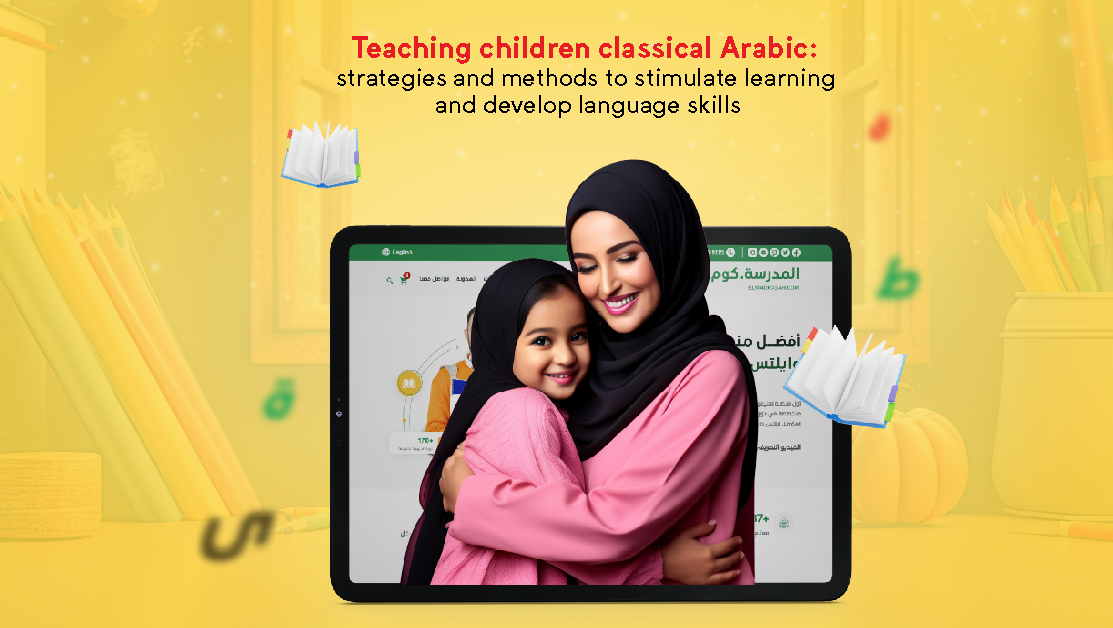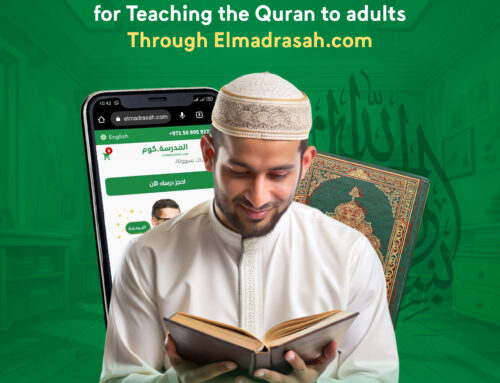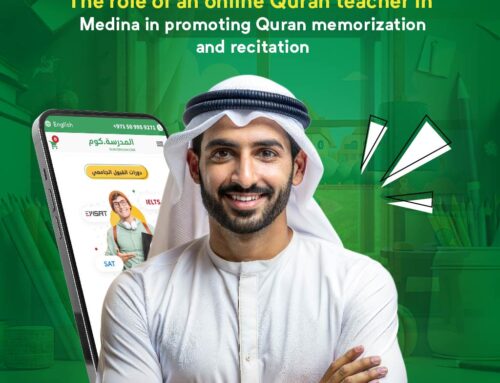
Arabic is currently the fourth most widely spoken and widely used language in the world and is spoken as an official language in 27 countries. The importance of the Arabic language is due to its antiquity, heritage, and deep roots in ancient Abrahamic history, which has been confirmed by modern studies. Some scholars point out that the Arabic language is superior to all other languages, with the exception of Hebrew and Syriac, which are most similar to the first Semitic language from which it emerged. This similarity between the two confirms that they have something in common. Elements such as grammaticalization and pluralization are not found in other languages derived from the early Semitic languages. Therefore, it is very important teaching children classical Arabic.
Why do we teach our children the Arabic language?
The answer simply lies in the clear importance of language as a human identity. The Arabic language represents our Arab identity, which is evident in a history full of achievements and civilizations, in addition to its spread in all sciences as an Arabic reference. It is responsible for all types and foundations of modern sciences in medicine, pharmacy, technology, astronomy, agriculture, physics and chemistry.
We Arabs also believe in the importance of the Arabic language, not only because of its structure, but also because of its sanctity, as the language of the Holy Quran. Because God chose the Arabic language as the language of communication with His Prophet, Muhammad, in order to convey his message to us and to all humanity.
Added to this is the importance of the Arabic language as the official language of communication, even if you speak the colloquial dialect instead of classical Arabic. However, in most formal talks, seminars and various conferences, only Standard Arabic is spoken. The Arabic language is evidence of the speaker’s fundamentalism and his affiliation to Classical Arabic, the most important language in the world. Therefore, it is very important teaching children the Arabic language.
Hence it becomes clear why we teach children the Arabic language. This is because it is important not to abandon our traditions and the faith that our language expresses, as they are at the forefront of the priorities of all members of society, and therefore the Arabic language is ingrained as an integral part of a person’s personality and formation that will remain with him until he fulfills his life’s mission.
The importance of speaking Arabic
Although it is believed that teaching children Arabic helps in preserving Arabic traditions, there are other related reasons that explain its importance:
- Most Islamic culture and Sharia sciences are recorded in Arabic in ancient references and books, so understanding them requires a comprehensive study of the Arabic language.
- The importance of learning the Arabic language comes from the ability to read and understand ancient texts such as Arabic poetry and prose, as well as reading the history of our ancestors and knowing their customs and traditions.
- Since the Arab countries constitute a large part of the world, the Arabic language has strategic importance, especially in expanding trade and cultural exchange between countries.
- The importance of learning Arabic is also evident in the ease with which you can learn other languages, such as Persian, which use the same script in both written and spoken language.
- The importance of learning the Arabic language is that it includes all the sounds from their correct phonemes. This does not apply to all other languages that are missing one or more letters. Therefore, Arabic has become the most widely used language. You can learn other languages because you can pronounce all sounds correctly from all audio outputs. Therefore, it is important teaching children classical Arabic.
How do I teach my son to read Arabic?
Reading is a complex process, but the steps to building this skill are very simple and easy:
- Building phonemic awareness: Nursery rhymes help teach rhyme and rhythm and help children hear the sounds and syllables of words. This is a good way to develop phonological awareness, which is one of the most important skills in learning to read. This is to ensure that children develop implicit literacy skills that help them become successful readers in the future.
- Word cards: Cut out a regular card, write a three-letter word, have your child choose a card, read the word together, and hold up three fingers.
- Ask them to say the first letter they hear in the word, then the second, then the third letter of the alphabet. Pay attention to the sounds each letter makes rather than the name of the letter.
- Print-rich environment: By observing words printed on posters and books, children can see and apply connections between sounds and letter symbols. When outside, encourage your child to notice the messages on signs and signs and to focus on the first letter of the word. Ask him: How do you pronounce this letter? Do you know another word that starts with this sound?
- Words game: Regularly focus on simple word games or games that encourage your child to listen, recognize and manipulate the sounds of words. For example, ask questions like: “What sound does this word start with?”
- Basic skills: You need to understand the basic skills to teach your child to read. This includes five basic elements: phonological awareness, the ability to hear and manipulate the different sounds in words, phonics, awareness of the relationships between letters and the sounds they make, and comprehension. Understanding the meaning of words, their definitions and contexts, the meaning of texts (whether children’s stories or information books), and the ability to read aloud with fluency, speed, comprehension and accuracy.
- The power of technology: Using computers, mobile phones and tablets gives children special pleasure. Take advantage of some websites that can help you learn to read and turn your child’s fun time into a learning opportunity. There are also many classic books for children to read. The application is available on mobile phones.
- Motivate your child: Learning to read should be a fun process to motivate children to improve. Children may enjoy learning at first, but when it becomes difficult, they quickly tire and give up.
- As his mother, you should pay attention to this stage and know how to motivate him again, such as using the reward system for completing tasks or reaching new levels.
- Dialogic reading: Many people don’t realize how many skills they can develop just by reading to their children. This not only teaches them how to pronounce words, but also develops basic comprehension skills and expands their vocabulary. Use the “interactive” reading method when: Invite your child to participate in the story.
- Before you turn the page, ask what you think will happen next. You can also ask your child how the book ends.
- Selection of books: Try to interest your child not only in fairy tales, but also in non-fiction books. Look for books that focus on his favorite topics, such as cars, dinosaurs, and animals. Richly illustrated and designed especially for children of this age.
- Be patient: All children learn at their own pace. Therefore, always remember that the most important thing is to read regularly, carefully choose the type of reading you prefer, and make reading fun by letting your child choose books from time to time. This will give him the opportunity to develop a love of reading from an early age and learn to read easily.
Teaching children the Arabic language in entertaining ways
Reading simple stories is an effective way to teach children the Arabic language, as it helps them develop their reading and comprehension skills and expand their vocabulary. Children love reading fairy tales because they get immersed in the story, stimulate their imagination, and have fun learning Arabic.
Animations also help children improve their reading and comprehension skills. You can choose age-appropriate stories that tell simple events using simple, easy-to-understand language.
When children enjoy reading, they become more interested in learning Arabic and are more motivated to continue learning, practicing and listening. Therefore, it is important teaching children classical Arabic.
Teaching children classical Arabic & Speaking Arabic
There are several methods you can use to teach your children Arabic, all of which are valid, but the benefits depend on the method you use. Teaching the Arabic language to students is not the responsibility of schools alone. However, home monitoring and language practice must be achieved through a variety of mechanisms.
These methods that aim to teach children the Arabic language have several forms and methods, the most important of which are:
- Teaching children the Arabic language through direct teaching sessions with teachers. Teachers begin by speaking to students in Arabic to introduce them to the sounds of the Arabic language, explain grammar and provide examples with regular assessment. One way for teaching children classical Arabic.
- Teaching children classical Arabic through the computer by displaying words and pictures with Arabic meanings and showing video clips explaining the letters in the form of fun stories.
- Teaching children classical Arabic through written pictures and comic stories using libraries and computers. This method aims to excite the child, add an element of anticipation, and prepare him to know how the story ends.
- Arabic is taught using a tutorial in which teachers explain and demonstrate grammar, but with this method there is insufficient assessment during and after learning, which makes it difficult to know whether the necessary educational objectives have been achieved or not and that can be considered a way for teaching children classical Arabic.
- Teaching children classical Arabic through online training courses is one of the best ways because the information is conveyed to the child by the teacher while you are in the comfort of your home and you can measure and know the child’s level. Evaluate him in terms of whether he achieved the lesson objectives. From this courses:
- Arabic language course for kindergarten online.
- Arabic language courses for children online.
Teaching children the classical Arabic language remotely
Helping children learn Arabic remotely is different from helping adults or non-native speakers learn Arabic. Because children need to learn Arabic to achieve some goals. The strategic importance of the Arab countries today, especially as they have opened up to the world in all fields.
Teaching children the classical Arabic language remotely has become one of the most important modern methods used by educational institutions, as the importance of distance learning emerged after the state emphasized the importance of distance learning due to the Corona virus, and it is one of the methods. What you learned online and how it contributed to achieving the necessary goals.
The importance of learning the Arabic language remotely for children is evident through a number of issues related to the child and family, including:
- Teaching children classical Arabic language remotely ensures their safety from exposure to physical or psychological harm.
- Early childhood education is like sculpting on stone, so establishing the Arabic language as an essential part of a child’s life through correspondence courses will definitely increase his belonging to the authentic Arab culture.
- Teaching children classical Arabic remotely will help them become more proficient than other students at the same educational stage, as most distance learning systems rely on modern educational media such as images, videos, and educational games.
- When children learn Standard Arabic remotely, they improve their ability to achieve their goals using modern technology, save time, and have a great learning environment in their own room.
- Teaching children classical Arabic remotely can help children as they can speak freely and express their thoughts without resorting to violence or reprimands from teachers during face-to-face classes.
- The importance of teaching children classical Arabic language remotely is highlighted by the ability of parents to monitor their children and ensure that they obtain the targeted knowledge, as well as the extent to which educational goals are achieved in addition to the child’s abilities. Check your child’s level through assessments they have completed in supervised learning courses.
Steps for teaching children classical Arabic with Elmadrasah.com
- To start teaching your children Arabic, you will have to hear many Arabic terms over and over again. This will identify it to the user and store it in memory for future use.
- Next comes the stages of learning Arabic sounds, pronunciation, reading, writing letters while taking into account the correct way to hold the pen, drawing and imitating letters, and walking around the letters in the form of dots connecting them. Others form letters.
- Next comes the stage of teaching your child how to read by defining words and adding pictures that represent them. Then expand that thing into a two-word sentence describing a picture, and then a three-word sentence. Likewise, recitation of the Qur’an can be used to teach children the correct way to read from an early age, which greatly helps in improving children’s reading and speaking skills.
- Then the child writes a word consisting of two letters, then 3 letters, then 4 letters, and reinforces the meaning of that word in his mind with a visual image. Then he writes a word consisting of two letters, then 3 letters, then 4 letters. He presents a sentence consisting of a visual image, then a sentence of three words, and so on.
- When it comes to speaking skills, children need to listen to short stories in Arabic, some songs and educational texts for children that come with videos and animations, so that they can then develop their tongue to learn classical Arabic without any complications until they get used to the pronunciation.
The website of Elmadrasah.com, we offer educational courses to teach children the classical Arabic language according to methodological standards that suit their ages and nature. We also employ the best Arabic language teachers who follow the latest teaching strategies and advanced teaching methods such as images, videos and tutorials. In addition to the benefits of games, and lessons on setting the right amount of time, you will also be provided with regular monitoring and evaluation, and exercises to ensure you are investing your time effectively.
The role of Elmadrasah.com in teaching children classical Arabic language:
The educational platform Elmadrasah.com plays an important role in helping children learn the Arabic language. Especially thanks to the various training courses and educational resources that help children and students learn the Arabic language easily at any time.
Below we will discuss the most important educational resources that our platform provides for teaching Arabic to children.
- We offer a variety of educational content. This platform provides diverse and comprehensive content for learning Arabic for children. This content may include storyboards, interactive games, songs, and educational activities. This allows children to expand their vocabulary and improve their reading, writing, listening and speaking skills.
- Track your progress and evaluate your performance. This platform allows children to track and evaluate their progress in learning the Arabic language. Interactive tasks and exercises are provided to help children apply and reflect on the skills they have learned. Children can also recognize their strengths and weaknesses and work to improve them. Interaction and participation: This platform encourages children
- Interaction and participation: This platform encourages children to interact and participate in the learning process. Children can interact with the content by solving puzzles and participating in interactive activities and exercises. Opportunities are provided for discussion and interaction with teachers and peers to improve language interaction and develop social skills.
- Flexibility of time and place: This platform allows children to learn at any time and place that suits them. Children can access content and activities through smart devices such as smartphones, tablets and computers. This gives children and parents the flexibility to organize learning time according to their needs.
- Guidance and assistance: The platform provides guidance and assistance to children in their learning process. Clear guidance and explanations of linguistics, grammar, reading, and writing concepts are provided. Children can get additional support if problems or questions arise.
In conclusion, the Arabic language enjoys very great importance among peoples, as it is the language of the Holy Qur’an. Therefore, it is very important to learn mastery of the Arabic language, whether for speakers or non-native speakers, especially children, because it is considered one of the most important languages in the world. Therefore, many methods and means must be developed by which It helps in mastering the Arabic language, and this is what is provided on the Elmadrasah.com platform. Among the recommendations that must be followed to master the Arabic language is to pay attention to continuing education, e-learning platforms, and social media in order to master the Arabic language. Therefore, it is very important for teaching children classical Arabic in a distinctive way.















